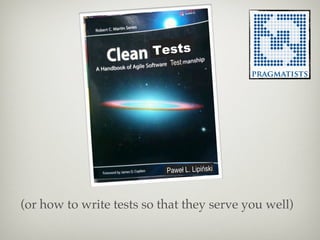
How to Write Tests that Serve You Well
- 1. Tests Test Paweł L. Lipiński (or how to write tests so that they serve you well)
- 2. pawel@agileee:/etc$whoami • 13 years as a developer • >10 years in Java • i did : development, consulting, trainings, audits, architecture, team leading • now: ‣ developer, coach & owner of pragmatists • 2nd time @ agileee
- 3. Agenda • writing tests so that they’re reliable • writing tests so that they document code • writing tests so that they’re maintainable • writing tests so that they’re readable
- 4. What do tests give? Tests • awareness of what is supposed to be written • feeling of safety while refactoring • feeling of safety while changing code • increase in development speed • executable documentation
- 5. So whatʼs the problem? • Whenever you change something - they stop working • They become harder and harder to maintain • They soon start to look like this • If there’s many of them, it’s hard to know where to look to learn something about the system
- 6. Process • Think First • Trivial First • Test specifies „what”, implementation says „how” • Different levels of tests
- 7. Conventions • coherent naming of test classes • coherent naming of tests • test classes’ names describing behaviour not the class’ name • test methods’ names should describe test case, not method being tested • code conventions
- 8. Comments • if you feel you must comment, something’s wrong with your code • tests should document code, so they must be SUPERCOMPREHENSIBLE • though comments are useful sometimes... // given // when // then
- 9. Formatting • coherent formatting throughout the codebase • separation of logical fragments • eyes used to it = quicker understanding
- 10. Given (test setup) • DRY (setup methods should be business-like) • setup method COMPREHENSIBLE • @Before vs. explicite call
- 11. Error handling • One test, one exception • NEVER: @Test(expected = Exception.class) Use only CONCRETE, UNIQUE exception • try / catch @Rule public ExpectedException throwing = ExpectedException.none(); ... ... // when throwing.expect(ParseException.class); parser.parse(text); // then exception is thrown
- 12. Behaviour Driven Development • define behaviours not tests • behaviours constitute a functional spec of the application • behaviours should be worked upon by business people together with developers • focus on why the code should exist • naming in code is the same as names used by the business people (ubiquitous language)
- 13. Defining behaviour As a conference attendee I want to get a restration status after signing up for a conference so that I know if the registration went fine: Given a conference „Agileee” When I try to register to it and the registration is successful Then I get a confirmation message: „You are registered to Agileee. An email with details has been sent to you.” Given a conference „Agileee” When I try to register to it but there are no free places Then I get a message: „Sorry. No free places left. Try the next year!”
- 14. Examples, not Tests • BDD helps to think about objects from the perspective of their behaviours, so the code is more object-oriented • examples help you create a „mental” model of the system • test class shows examples of use of a functionality • test code is an example of behaviour • test code is also an example of use
- 15. BDD naming Story, Scenario public class AddingBooksToLibraryTest { @Mock private BookRepository bookRepository; @Test public void shouldEnableAddingNewBooks() { // given Library library = new Library(bookRepository); Book book = new Book("Children from Bullerbyn"); // when library.add(book); // then assertThat(library.size()).is(1); verify(bookRepository).save(book); } }
- 16. BDD rules • test names should be sentences • simple constant template of the sentence helps you focus in the test on one thing public void shouldBeSearchedByName() • understandable test name helps when the test fails • test are examples - think about them not as a means for future verification, but as a documentation of behaviour
- 19. A-TDD • Acceptance tests may drive the development of scenarios. • But the need to be: ‣ written by business people (or at least with them nearby) ‣ verify correctness of scenario accomplishment (be complete and fulfill acceptance criteria) ‣ be automatic ‣ be maintainable • These are high-level tests, so changes to the application may force you to modify many of them
- 20. Whole system tests organisation • Tests in the same packages as SUT vs. separately • Tests named by the functionality vs. tests named by tested classes • Tests’ speed • Test levels clicking acceptance integration unit
- 21. Test smells • Long setup - lack of factory method, or perhaps a problem with the structure of created objects? • Long tests - perhaps you’re testing more than one behaviour at a time? • Many assertions - doesn’t the tested method have too many responsibilities? • Too many test methods in a test class - class under test has too many responsibilities? Or maybe you’re testing more than one functionality in a single class?
- 22. Maintainable tests • Reuse assertions, create „business” assertions • Reuse object construction methods - don’t be sensitive to changes of constructors • Reuse test setup • Tests should not depend on environment and order of execution • Avoid many assertions - when the first one fails, others are not executed (they could’ve give you a clue about possible reasons) • Separate assertion from the action to increase readability (or better use given/when/then pattern) • Use variables to pass and verify values in tests • Remove tests ONLY when you remove a functionality or when tests’ responsibilities overlap
- 23. TO WRITE READABLE TESTS
- 24. Thank you! pawel.lipinski@pragmatists.pl http://www.pragmatists.pl All pictures were used exclusively to set the presentation context and advertise the original book.
